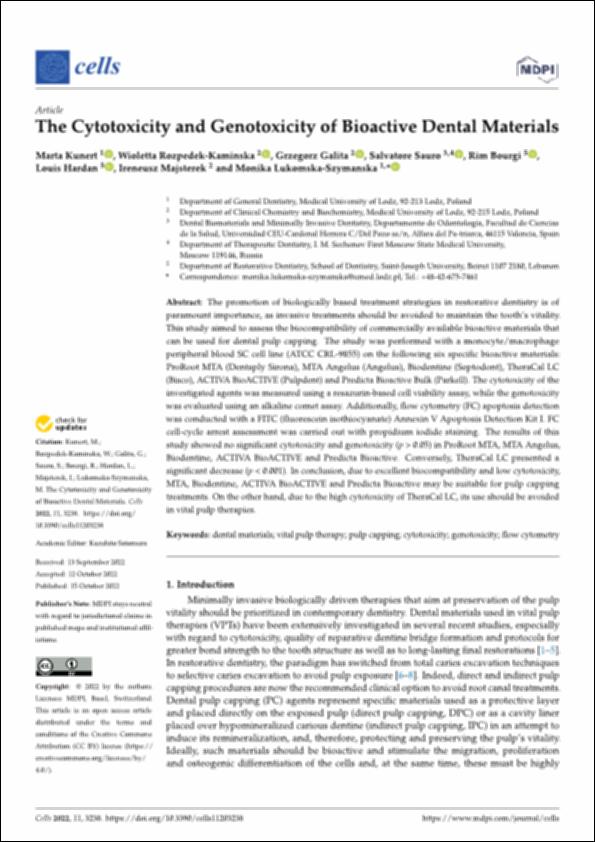Please use this identifier to cite or link to this item:
http://hdl.handle.net/10637/14356The cytotoxicity and genotoxicity of bioactive dental materials
| Title: | The cytotoxicity and genotoxicity of bioactive dental materials |
| Authors : | Kunert, Marta Rozpedek-Kaminska, Wioletta Galita, Grzegorz Sauro, Salvatore. Bourgi, Rim Hardan, Louis Majsterek, Ireneusz Lukomska-Szymanska, Monika |
| Keywords: | Genetic toxicology.; Pulpa dental.; Materiales dentales.; Dental materials.; Endodoncia.; Dental pulp.; Endodontics.; Terapéutica dental.; Dental therapeutics.; Toxicología genética. |
| Publisher: | MDPI |
| Citation: | Kunert, M., Rozpedek-Kaminska, W., Galita, G., Sauro, S., Bourgi, R., Hardan, L., Majsterek, I. et al. (2022). The cytotoxicity and genotoxicity of bioactive dental materials. Cells, vol. 11, i. 20 (15 oct.), art. 3238. DOI: http://dx.doi.org/10.3390/cells11203238 |
| Abstract: | The promotion of biologically based treatment strategies in restorative dentistry is of paramount importance, as invasive treatments should be avoided to maintain the tooth’s vitality. This study aimed to assess the biocompatibility of commercially available bioactive materials that can be used for dental pulp capping. The study was performed with a monocyte/macrophage peripheral blood SC cell line (ATCC CRL-9855) on the following six specific bioactive materials: ProRoot MTA (Dentsply Sirona), MTA Angelus (Angelus), Biodentine (Septodont), TheraCal LC (Bisco), ACTIVA BioACTIVE (Pulpdent) and Predicta Bioactive Bulk (Parkell). The cytotoxicity of the investigated agents was measured using a resazurin-based cell viability assay, while the genotoxicity was evaluated using an alkaline comet assay. Additionally, flow cytometry (FC) apoptosis detection was conducted with a FITC (fluorescein isothiocyanate) Annexin V Apoptosis Detection Kit I. FC cell-cycle arrest assessment was carried out with propidium iodide staining. The results of this study showed no significant cytotoxicity and genotoxicity (p > 0.05) in ProRoot MTA, MTA Angelus, Biodentine, ACTIVA BioACTIVE and Predicta Bioactive. Conversely, TheraCal LC presented a significant decrease (p < 0.001). In conclusion, due to excellent biocompatibility and low cytotoxicity, MTA, Biodentine, ACTIVA BioACTIVE and Predicta Bioactive may be suitable for pulp capping treatments. On the other hand, due to the high cytotoxicity of TheraCal LC, its use should be avoided in vital pulp therapies. |
| Description: | Este artículo se encuentra disponible en la siguiente URL: https://www.mdpi.com/2073-4409/11/20/3238 Este artículo de investigación pertenece al número especial "Mineralized Tissues Repair and Regeneration". |
| URI: | http://hdl.handle.net/10637/14356 |
| Rights : | http://creativecommons.org/licenses/by/4.0/deed.es |
| ISSN: | 2073-4409 (Electrónico) |
| Language: | es |
| Issue Date: | 15-Oct-2022 |
| Center : | Universidad Cardenal Herrera-CEU |
| Appears in Collections: | Dpto. Odontología |
Items in DSpace are protected by copyright, with all rights reserved, unless otherwise indicated.


